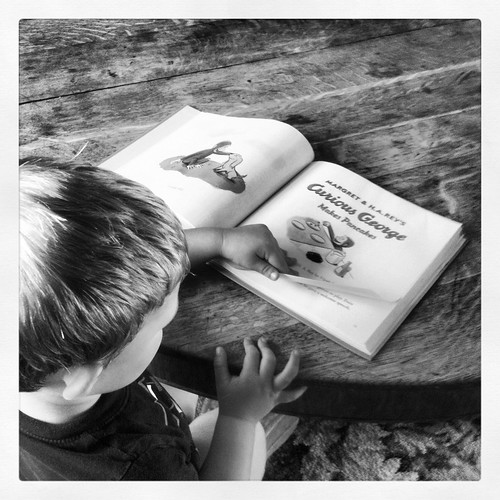This photo is of my little monkey of a fairy-god-child. He's developed quite a fascination with Curious George and spends what I would consider a fair amount of time for a 2 & 1/2 year old looking at the pictures. He has a fairly decent attention span. I myself had a stuffed Curious George as a child. I hauled that poor thing everywhere until both his face and feet started to disintegrate. I remember patching one of his feet with yellow felt but I am not sure what happened to poor old George. He had a good life, though. He was loved.
I babysat my fairy-god-kids yesterday and they were pretty good, though the little boy dumped a whole jar of parmesan on his dinner - I turned my back for just a second I swear - and his sister drowned her food in hoisin sauce. She's 5 and knows EVERYTHING. It was too hot to eat much anyway. We lay around pretending the living room was the Moon and the porch was Mars. The Moon is quite pleasant at this time of year. I may not have been the fun energetic babysitter but our imaginations got some good exercise.
Speaking of long voyages... back to the Oregon Trail. I have more to say about that. Here is the suggested list of provisions to be taken per person. I am not sure where this list originated but I have seen it in several books, all obviously quoting the same source. There were some general guides for emigrants that are now in public domain, so it was probably from one of those.
Mind you, this is PER PERSON:
*200 pounds flour
*150 pounds bacon
*20 pounds sugar
*10 pounds coffee
*10 pounds salt
various amounts of: cornmeal, cured meats, dried beans, fruit, tea, baking soda, vinegar, pickles, and mustard.
I think what creeps me out the most is the 10 pounds per person of salt. That is a lot! But I suppose they may have used some of it to preserve or cure game meat that they shot on the trail. The fruit was often taken as dried fruit, and it was taken because the pioneers knew they needed it to avoid getting scurvy. Some of the supplies were also probably to get them started once they reached their destinations. Once they left Missouri there were only a few places to get supplies along the way -- Fort Kearney, Fort Laramie, and Fort Bridger.
It's hard to understand now what a huge step they were taking. They were leaving their country and setting off into the wilds. At that time the land West of Missouri and Texas was not part of the US. California and a lot of the land around it belonged to Mexico. Oregon was not yet a US Territory. Oregon became a territory in 1858, then became a state in 1859. Washington State was not much explored by white settlers at that point and was not even a territory. At first it was called Northern Oregon. Later it was called Columbia, after the Columbia River. When the early settlers of Washington started lobbying to become a territory and then a state, they had wanted to call the state Columbia, but officials in Washington D.C. thought that would be confusing because the District of Columbia had just been set up, so they changed the name to Washington, in honor of George Washington. Apparently it did not occur to them that giving a state the same name as the nation's capital might ALSO be confusing. Washington State does have the honor of being the only state named after a U.S. president, though. Washington became the 42nd state in the United States on November 11, 1889.
Saturday, August 4, 2012
Little Monkey & More on the Oregon & NW History
Subscribe to:
Post Comments (Atom)


No comments:
Post a Comment